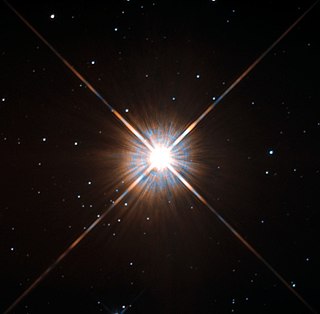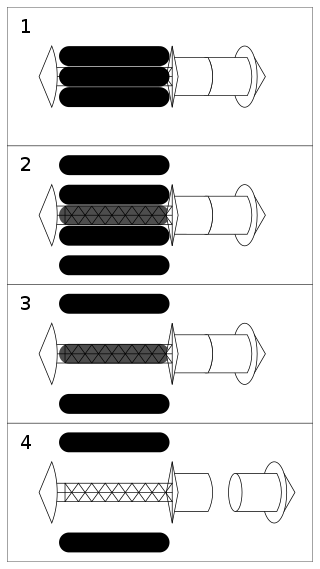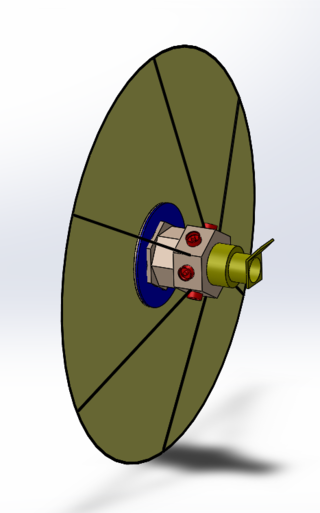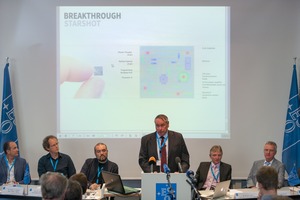
Alpha Centauri is a triple star system in the southern constellation of Centaurus. It consists of three stars: Rigil Kentaurus, Toliman (B) and Proxima Centauri (C). Proxima Centauri is the closest star to the Sun at 4.2465 light-years.

Interstellar travel is the hypothetical travel of spacecraft from one star system, solitary star, or planetary system to another. Interstellar travel is expected to prove much more difficult than interplanetary spaceflight due to the vast difference in the scale of the involved distances. Whereas the distance between any two planets in the Solar System is less than 55 astronomical units (AU), stars are typically separated by hundreds of thousands of AU, causing these distances to typically be expressed instead in light-years. Because of the vastness of these distances, non-generational interstellar travel based on known physics would need to occur at a high percentage of the speed of light; even so, travel times would be long, at least decades and perhaps millennia or longer.

Solar sails are a method of spacecraft propulsion using radiation pressure exerted by sunlight on large surfaces. A number of spaceflight missions to test solar propulsion and navigation have been proposed since the 1980s. The first spacecraft to make use of the technology was IKAROS, launched in 2010.

A starship, starcraft, or interstellar spacecraft is a theoretical spacecraft designed for traveling between planetary systems. The term is mostly found in science fiction. Reference to a "star-ship" appears as early as 1882 in Oahspe: A New Bible.

Proxima Centauri is a small, low-mass star located 4.2465 light-years (1.3020 pc) away from the Sun in the southern constellation of Centaurus. Its Latin name means the 'nearest [star] of Centaurus'. It was discovered in 1915 by Robert Innes and is the nearest-known star to the Sun. With a quiescent apparent magnitude of 11.13, it is too faint to be seen with the unaided eye. Proxima Centauri is a member of the Alpha Centauri star system, being identified as component Alpha Centauri C, and is 2.18° to the southwest of the Alpha Centauri AB pair. It is currently 12,950 AU (0.2 ly) from AB, which it orbits with a period of about 550,000 years.

Project Daedalus was a study conducted between 1973 and 1978 by the British Interplanetary Society to design a plausible uncrewed interstellar probe. Intended mainly as a scientific probe, the design criteria specified that the spacecraft had to use existing or near-future technology and had to be able to reach its destination within a human lifetime. Alan Bond led a team of scientists and engineers who proposed using a fusion rocket to reach Barnard's Star 5.9 light years away. The trip was estimated to take 50 years, but the design was required to be flexible enough that it could be sent to any other target star.

Project Longshot was a conceptual interstellar spacecraft design. It would have been an uncrewed starship, intended to fly to and enter orbit around Alpha Centauri B powered by nuclear pulse propulsion.

An interstellar probe is a space probe that has left—or is expected to leave—the Solar System and enter interstellar space, which is typically defined as the region beyond the heliopause. It also refers to probes capable of reaching other star systems.
Project Icarus is a theoretical engineering design study aimed at designing a credible, mainly nuclear fusion-based, unmanned interstellar space probe. Project Icarus was an initiative of members of the British Interplanetary Society (BIS) and the Tau Zero Foundation (TZF) started in 2009. The project was under the stewardship of Icarus Interstellar until 2019. It remains a BIS project.

The Enzmann starship is a concept for a crewed interstellar spacecraft proposed in 1964 by Dr. Robert Enzmann. A three million ton ball of frozen deuterium would fuel nuclear fusion rocket engines contained in a cylindrical section behind that ball with the crew quarters. The craft would be about 2,000 feet (600 m) long overall.
Kevin L.G. Parkin is an American British scientist who is best known for his study of beamed energy propulsion.
The Initiative for Interstellar Studies (i4is) is a UK-registered not-for-profit company, whose objectives are education and research into the challenges of Interstellar Travel. It pioneered small-scale laser sail interstellar probes and missions to interstellar objects. Several of its principals were involved in the 100 Year Starship winning team originated by NASA and DARPA.
Breakthrough Initiatives is a science-based program founded in 2015 and funded by Julia and Yuri Milner, also of Breakthrough Prize, to search for extraterrestrial intelligence over a span of at least 10 years. The program is divided into multiple projects. Breakthrough Listen will comprise an effort to search over 1,000,000 stars for artificial radio or laser signals. A parallel project called Breakthrough Message is an effort to create a message "representative of humanity and planet Earth". The project Breakthrough Starshot, co-founded with Mark Zuckerberg, aims to send a swarm of probes to the nearest star at about 20% the speed of light. The project Breakthrough Watch aims to identify and characterize Earth-sized, rocky planets around Alpha Centauri and other stars within 20 light years of Earth. Breakthrough plans to send a mission to Saturn's moon Enceladus, in search for life in its warm ocean, and in 2018 signed a partnership agreement with NASA for the project.

Project Dragonfly is the first conceptual design study that assesses the feasibility of a laser-propelled interstellar probe, conducted by the Initiative for Interstellar Studies. Contrary to past unmanned interstellar mission studies such as Project Daedalus and Project Icarus, the focus is particularly on a small spacecraft. The project was founded in 2013 by the Initiative for Interstellar Studies (i4is).

Proxima Centauri b, sometimes referred to as Alpha Centauri Cb, is an exoplanet orbiting within the habitable zone of the red dwarf star Proxima Centauri, which is the closest star to the Sun and part of the larger triple star system Alpha Centauri. It is about 4.2 light-years from Earth in the constellation Centaurus, making it and Proxima d, along with the currently disputed Proxima c, the closest known exoplanets to the Solar System.
The future of space exploration involves both telescopic exploration and the physical exploration of space by robotic spacecraft and human spaceflight.

In December 2017, NASA released a mission concept involving the launch, in 2069, of an interstellar probe to search for signs of life on planets orbiting stars in and around the Alpha Centauri system. The announcement was at the annual conference of the American Geophysical Union. The mission remains a concept, and as such, has no name or allocated funding.
Project Starlight is a research project of the University of California, Santa Barbara to develop a fleet of laser beam-propelled interstellar probes and sending them to a star neighboring the Solar System, potentially Alpha Centauri. The project aims to send organisms on board the probe.

BLC1 was a candidate SETI radio signal detected and observed during April and May 2019, and first reported on 18 December 2020, spatially coincident with the direction of the Solar System's closest star, Proxima Centauri.















